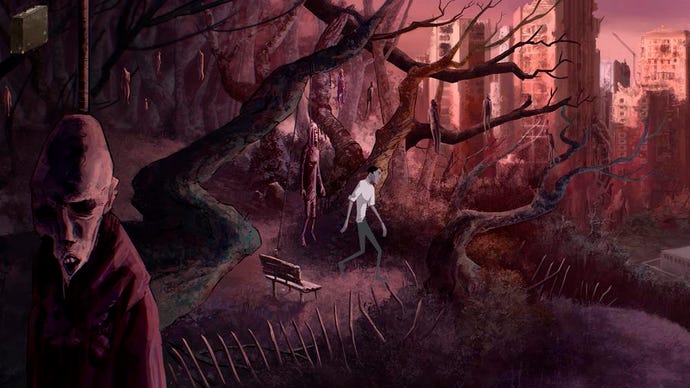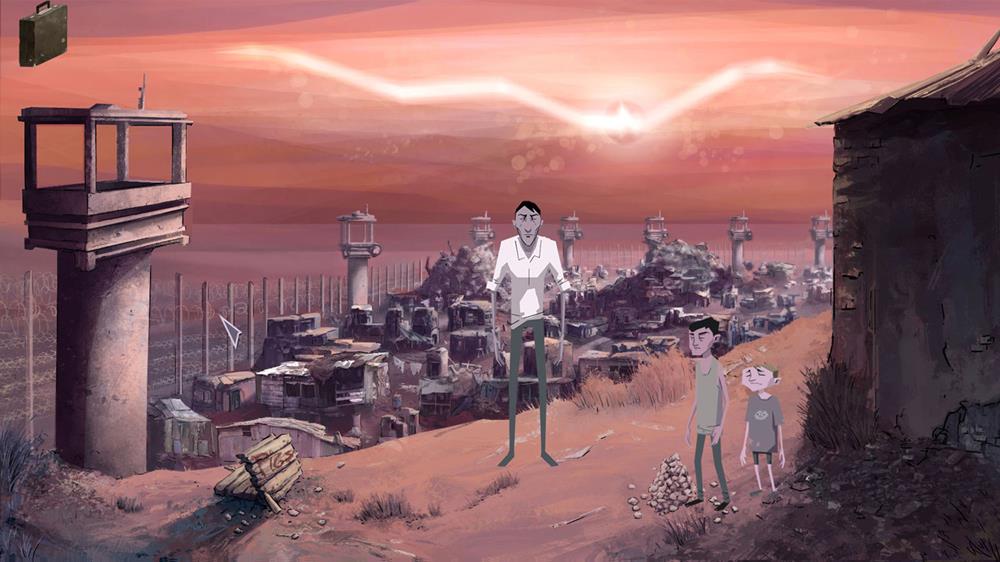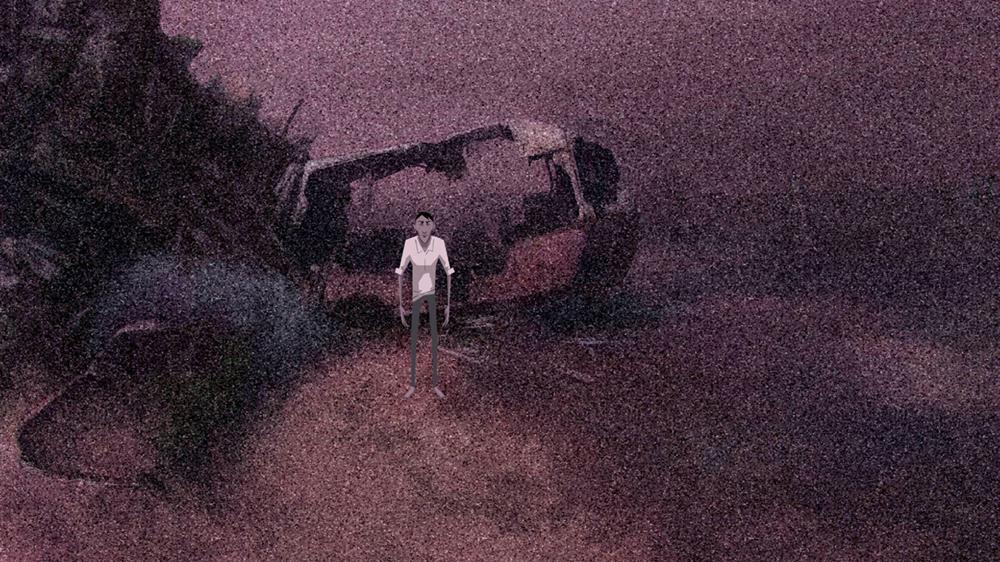Dead Synchronicity: hope in a world on borrowed time
Dead Synchronicity: Tomorrow Comes Today is the new dystopian adventure game from indie team Fictiorama Studios. It presents a new breed of apocalypse, one that sees the fabric of time dissolving while the populace lose their memories. Intrigued by the premise and the game's bleak but impressive art style, Dave Cook spoke with the team to find out more.
”Within about five minutes of starting the Dead Synchronicity alpha demo I witnessed a sick women being hauled into the back of a van by armed guards, before they turned around and shot her protesting husband dead without negotiation. It’s thoroughly depressing.”
Zombies, alien invasion, nuclear war, and World War III are common set-ups for post-apocalyptic games. While the shuffling march of the undead seems unlikely to go away any time soon, how does one come up with a game set after the downfall of man while skirting round these tonal preconceptions? That was a common problem facing the members of Dead Synchronicity: Tomorrow Comes Today developer Fictiorama Studios, but thankfully, it's one that appears to have been solved.
The point-and-click adventure game is accepting backers on Kickstarter right now, and at the time of writing the campaign has made $13,947 towards the team's $45,000 goal. With a tone inspired by Cormac McCarthy’s seminal novel The Road and the works of Joseph Conrad and Andrei Tarkovski, the game's incredibly dark premise underlines the despair of humanity's final days, and will see players thrown out of their comfort zone often.
It takes place some time after a cataclysmic event called The Great Wave has caused society's infrastructures to crumble, stripping the planet of commodities like electricity and running water. To make matters worse, an illness is spreading through the ravaged world, erasing memories and turning victims into The Dissolved, beings with supernatural abilities.
Fearful of the disease's true nature, the powers that be have established prison camps to keep the poor rounded up like cattle, executing anyone who turns dissolved. Then there's the matter of strange anomalies breaking out at random intervals as the fabric of time itself erodes to a point of Dead Synchronicity.
”Oliván dropped the game’s similarities to McCarthy's The Road into our exchange and stressed the worlds of both properties are similar, in that they are both places where basic human needs cannot be fulfilled, and the terrible price men and women pay to get what they desire.”
Needless to say; the world is a total mess, and within about five minutes of starting the Dead Synchronicity alpha demo I witnessed a sick women being hauled into the back of a van by armed guards, before they turned around and shot her protesting husband dead without negotiation.
It's thoroughly depressing, but the mystery that surrounds Fictiorama's unique apocalypse keeps things interesting indeed. You play as Michael, a man whose mind has become erased by The Great Wave - dubbed 'Blankheads' - as he sets out into the world in search of an identity and purpose. Of course, that initial aim will grow complex as new problems present themselves.
"With so many titles featuring some kind of dystopian atmosphere, were we going to do one more?" Fictiorama's Luis Oliván muses over email, adding, "we wanted to get a truly dark vision of the post-apocalyptic situation. In our game, the player will see how a new kind of day-to-day living has emerged, and it has nothing to do with the pre-Great Wave situation. Sickness, death, violence and some kind of inner cruelty has spread all over the New World.
"The player themselves, in order to finish the game, will have to do things that they won’t probably like doing. So, to some extent, we want to push the player to its moral limits and see if they understood that Michael lives in a world where rules have been changed."
You will learn early on the true extent of the New World's dog-eat-dog nature. Within Michael's prison camp exist Moles - snitches who rat out the locations of potential Dissolved so they can be hauled off to a secret facility. It's made clear that those who get dragged away never return, which comes to a head as you realise someone in your own midst is showing signs of the affliction. Early gameplay images show Michael walking through a forest where the trees are decorated with Dissolved singing from nooses, suggesting that suicide is favourable over such 'processing.'
”Regarding puzzles, we know there are a lot of likes and dislikes amongst adventure lovers. We find it plausible to include surrealistic puzzles in a crazy game like Day of the Tentacle, but we think they wouldn’t fit our game. So, our puzzles will be quite reality-based which doesn’t mean they will be obvious.”
Oliván drops the game's similarities to McCarthy's The Road into our exchange and stressed the worlds of both properties are similar, in that they are both places where basic human needs cannot be fulfilled, and the terrible price men and women pay to get what they desire.
He adds, "In our Kickstarter campaign we describe Dead Synchronicity: Tomorrow comes Today as ‘Guybrush meets 12 Monkeys meets Mad Max.'" The comparison to Monkey Island is certainly apt from a mechanical point-and-click perspective, but a comedy this is not.
"One of our goals when creating the game was to get a distinctive, eye-catching art style," Oliván went on. "Graphics are the first thing you usually experience in a video game and, furthermore, almost the only thing you can judge when you see a screenshot. When [artist Martín Martínez] joined Fictiorama, we spent quite a long time just trying, looking for the proper style that would fit the story’s mood. For characters, we wanted to get a tough, curve-less, angular style. So, we studied the two most powerful references we could think of: expressionism and tribal art.
"For locations, we wanted to achieve a rusty, shabby look. In fact, most of the palettes the game features include ochre, blue, green shades. In a nutshell; cold, oxidized tones. I’m not the one to say if we have achieved our goal or not, but the truth is that, according to the media, the users on social networks, and the comments on Kickstarter and Greenlight, the style of Dead Synchronicity: Tomorrow comes Today leaves no one cold."
"We want to recover, to some extent, the 'open-world' experience of free-roaming that the adventures of the 90’s had."
While Oliván has a point - that the art style is both warming and defining from a stylistic perspective - the images portrayed within are effective at establishing a miserable tone. This harrowing tone even enters into the game's first puzzle, which sees Michael snagging the sole of his bare foot on a metal shard, prompting him to find a pair of shoes.
The footwear he finds is rotten and filthy, so to avoid gangrene you have to then seek a way of sterilising the shoes and your wound before proceeding. That's real survivalist material, where the world is so broken that even finding something to cover your feet proves to be a puzzle.
"Regarding puzzles, we know there are a lot of likes and dislikes amongst adventure lovers," Oliván explains. "We find it plausible to include surrealistic puzzles in a crazy game like Day of the Tentacle, but we think they wouldn’t fit our game. So, our puzzles will be quite reality-based which doesn’t mean they will be obvious.
"When players solve the puzzles of Dead Synchronicity we want them to wonder 'how couldn’t I think of that before?' instead of 'who could have thought of that?' Regarding gameplay, we have bet on a sure thing: items, an inventory, characters, branched conversation. If it works, don’t fix it. I would like to remark that we want to recover, to some extent, the 'open-world' experience of free-roaming that the adventures of the 90’s had.
"Unlike a lot of adventure games that seem made up of 'tiny adventure games' in a row, this open approach will give the player the chance to progressively interact with plenty of locations and characters, and to face different puzzles simultaneously. We think this is a key element to get an intense, immersive experience for the player."
It's assuring to see Fictiorama offering gamers an open-ended approach to adventure gaming, one that doesn't take them through systematic locations that exist as puzzle-rooms rather than smaller parts of a larger world. While the freedom to roam is welcome, this could lead to many head-scratching conundrums that might challenge unseasoned adventure players. Either way, Dead Synchronicity will not be for the weak of stomach, but those looking to drink in a soul crushing yet inviting new spin on post-apocalyptic fiction.
Dead Synchronicity: Tomorrow Comes Today is currently in development for PC, Mac and iOS, with Linux as a stretch goal. You can back the project on Kickstarter or vote for it over on Steam Greenlight.





